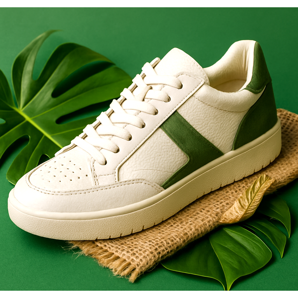
Sustainable fashion in shoes - ecological brands and materials
Is it possible to combine style with concern for the environment? Discover the world of ecological footwear! Discover innovative materials such as pineapple or mushroom leather, meet brands focusing on sustainable development and find out how to build a conscious shoe wardrobe.

Revolution in materials - an alternative to traditional leather
The footwear industry undergoes a real material revolution. Traditional animal skin, which has been a basic raw material for centuries, is gradually replaced by innovative, ecological alternatives. Friday - pineapple leather, also known as PINATEX, is a material made from pineapple cultivation waste. It is durable, waterproof and has a texture very similar to natural leather. Traffic jams? No, it's not just soles material. Modern technologies allow you to create flexible and durable boots of shoes. Mycelium, or 'leather' from mushrooms, is one of the latest breakthroughs. This material differs three weeks, is fully biodegradable, and its properties are almost identical to animal skin. Brands like Hermès and Adidas are already experimenting with this material, creating luxurious collections.
Eco -workers that are worth knowing - pioneers of sustainable fashion
There are more and more brands on the market that put ecology in the first place. Veja, a French sports brand, has been using organic cotton for years, wild gums from Amazon and vegetable tanned skin. Each pair of shoes is not only style, but also support for local communities. Allbirds has revolutionized the Merino wool market from New Zealand. Their sneakers are 100% natural, sliced and extremely comfortable. The company also boasts of carbon neutrality - they produce every pair of shoes with a zero carbon trail. Rothy's creates beautiful ballerinas and loafer entirely from recycled plastic bottles. One pair of shoes is even 7 processed bottles! What's more, the shoes can be washed in the washing machine, which significantly extends their service life.
How to recognize really organic shoes
Unfortunately, not everything that the slogans of ecologicality are really environmentally friendly. The phenomenon of 'greenwashing' also affects the footwear industry. How to recognize brands actually involved in environmental protection? First, check the certificates. Gots (Global Organic Textile Standard), Oeko-Tex, or Cradle to Cradle are reliable ecological markings. Secondly, analyze the supply chain - is the brand transparent as to the origin of materials and production conditions? The activities of companies outside of production are also important: do they invest in renewable energy sources? Do they have old shoes recycling programs? Do they support local communities? Truly ecological brands treat sustainable development comprehensively.
The price of ecology - is it worth investing
Ecological shoes often cost more than their conventional counterparts. Does this investment pay off? The answer is clearly positive if we look at it long -term. First, quality. Brands focusing on sustainable development often produce shoes with a view to longevity. They use better materials, more solid workmanship. One pair of good ecological shoes can replace several cheap couples from Fast Fashion. Secondly, environmental impact. By choosing conscious brands, you invest in the future of our planet. Reduction of coal trace, reduction of water consumption, no harmful chemicals - all this has a real impact on the ecosystem. Third, comfort of use. Natural materials are often more comfortable, allow their feet to breathe, they do not cause allergies.
Care of ecological shoes - how to reduce their service life
Ecological shoes require slightly different care than traditional ones. Natural materials can be more sensitive to weather conditions, but with proper care will serve for years. For shoes made of plant materials, use mild, natural cleaning agents. Avoid aggressive chemicals that can damage delicate fibers. Cleansed, white vinegar or natural natural was your friends. Proper storage is the basis. Shoes made of natural materials need ventilation. Do not keep them in plastic boxes or bags. Use the correct cedars or newspapers to keep shape. Regular impregnation is the key to longevity. Use ecological impregnants based on natural waxes that protect the material against moisture without clogging the lieutenant